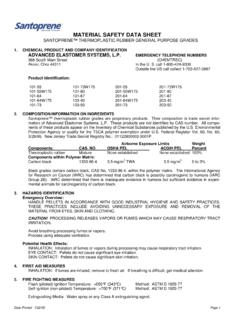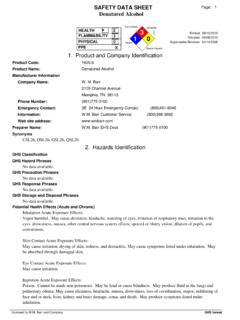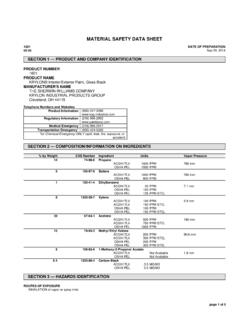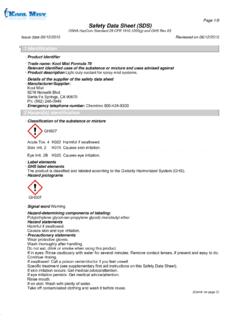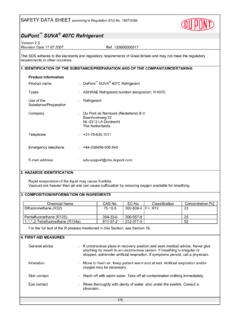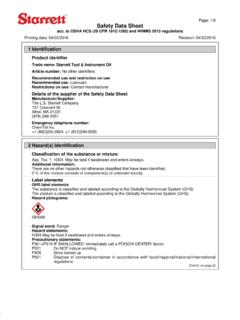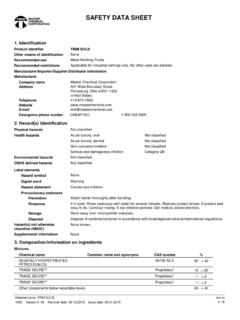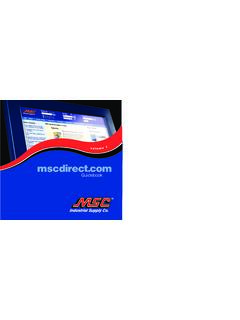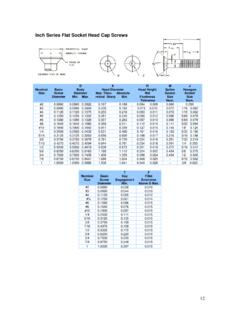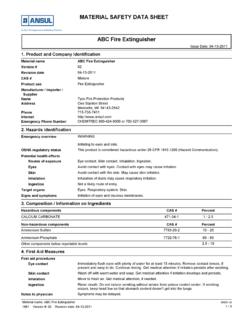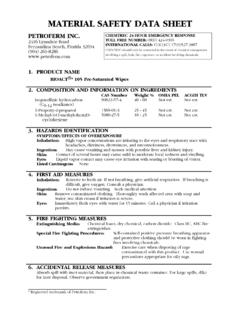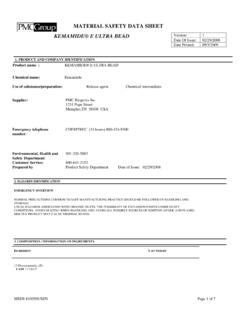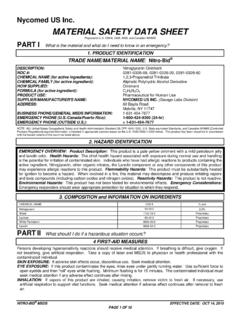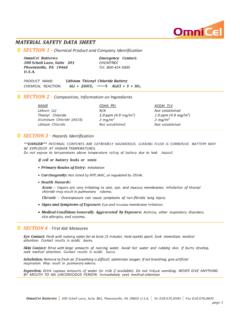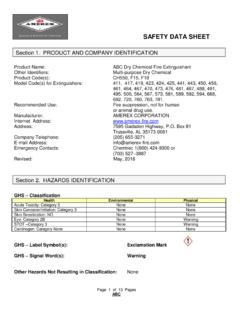Transcription of MATERIAL SAFETY DATA SHEET - MSC Industrial …
1 SAFETY data SHEET . Prepared to OSHA, CMA, ANSI, Canadian WHMIS Standards, European Union CLP EC 1272/2008 and the Global Harmonization Standard PART I What is the MATERIAL and what do I need to know in an emergency? 1 IDENTIFICATION OF THE SUBSTANCE/MIXTURE AND OF THE COMPANY/UNDERTAKING. IDENTIFICATION of the SUBSTANCE or PREPARATION: TRADE NAME (AS LABELED): STANLEY CHALKS. SYNONYMS: Stanley Black Chalk; Stanley Blue Chalk Stanley Red Chalk; Stanley White Chalk CHEMICAL NAME/CLASS: Calcium Carbonate/Pigment/Silica Mixtures RELEVANT USES of the MIXTURE: Chalks USES ADVISED AGAINST: Other than Relevant Use SUPPLIER OF THE SAFETY data SHEET : MANUFACTURER'S NAME: STANLEY WORKS. ADDRESS: 480 Myrtle Street New Britain, CT 06053.
2 BUSINESS PHONE: 1-800-262-2161. EUROPEAN SUPPLIER/IMPORTER'S NAM: ADDRESS: BUSINESS PHONE: EMERGENCY PHONE: CHEMTREC: 1-800-424-9300 ( , Canada, Puerto Rico. Virgin Islands). +1-703-527-3887 (outside areas above, call collect). DATE OF PREPARATION: December 11, 2007. DATE OF REVISION: July 18, 2013. ALL WHMIS required information is included in appropriate sections based on the ANSI format. This MATERIAL has been classified in accordance with the hazard criteria of the CPR and the SDS. contains all the information required by the CPR. The MATERIAL is also classified per all applicable EU Directives through EC 1907: 2006, the European Union CLP EC 1272/2008 and the Global Harmonization Standard. 2. HAZARD IDENTIFICATION.
3 GLOBAL HARMONIZATION LABELING AND CLASSIFICATION: Classified in accordance with CLP Regulation (EC) 1272/2008. Classification: Carcinogenic Cat. 2. Signal Word: Warning Hazard Statement Codes: H351; For Blue Chalk Only: EUH032. Precautionary Statement Codes: P201, P202, P280, P308 + P313, P405, P501. Hazard Symbol/Pictogram: GHS08. EU 67/548/EEC LABELING AND CLASSIFICATION: Classified in accordance with the European Community Council Directive 67/548/EEC or subsequent Directives. Classification: Carcinogenic Cat. 3 Risk Phrase Codes: R45; For Blue Chalk Only: R32. SAFETY Phrase Codes: S(1/2), S22, S25, S36/37/39, S38, S45, S53. Hazard Symbol: Xn See Section 16 for full text of Classification EMERGENCY OVERVIEW: Product Description: These products are colored, finely powdered, odorless chalks.
4 Health Hazards: Inhalation of dusts from this product may irritate the respiratory system. Skin and eye contact may cause mechanical abrasion. These chalks contain Crystalline Silica, a known human carcinogen by inhalation. Flammability Hazards: These chalks are not flammable. Finely divided dusts from these products can form explosive mixtures in air. If involved in a fire, these products may decompose to form iron oxides, aluminum oxides, silicon dioxide, sulfur dioxide, magnesium oxides, carbon oxides and calcium oxides. Reactivity Hazards: These chalks are not normally reactive. For the Blue Chalk, contact with acids can release toxic hydrogen sulfide. Environmental Hazards: These products are not expected to pose significant harm to the environment, however all release to the environment should be avoided.
5 Emergency Recommendations: Emergency responders must wear the personal protective equipment suitable for the situation to which they are responding. 3. COMPOSITION and INFORMATION ON INGREDIENTS. CHEMICAL NAME CAS # EINECS # % w/w LABEL ELEMENTS. EU Classification (67/548/EEC). GHS & EU Classification (1272/2008 EC). Risk Phrases/Hazard Statements Limestone/Calcium Carbonate (CaCO3) 1317-65-3 215-279-6 70-100% EU 67/548: Classification: Not applicable. GHS & EU 1272/2008: Classification: Not applicable. See Section 16 for full text of Classification STANLEY CHALKS SDS. PAGE 1 OF 8. STANLEY CHALKS SDS. 3. COMPOSITION and INFORMATION ON INGREDIENTS (Continued). CHEMICAL NAME CAS # EINECS # % w/w LABEL ELEMENTS.
6 EU Classification (67/548/EEC). GHS & EU Classification (1272/2008 EC). Risk Phrases/Hazard Statements Crystalline Silica 14808-60-7 238-878-4 SELF-CLASSIFICATION. EU 67/548. Classification: Carcinogenic Cat. 3. Risk Phrase Codes: R45. GHS and EU 1272/2008. Classification: Carcinogenic Cat. 2. Hazard Codes: H351. The following are pigments in each of the chalks: Blue Chalk: Sodium Alumino 57455-37-5 Unlisted 20-30% SELF-CLASSIFICATION. Pigment Blue 29 EU 67/548. Classification: None Risk Phrase Codes: R32. GHS and EU 1272/2008. Classification: None Supplemental Hazard Codes: EUH032. Red Chalk: Hematite/Iron Oxide (Fe2O3) 1317-60-8 215-275-4 20-30%^ EU 67/548: Classification: Not applicable. GHS & EU 1272/2008: Classification: Not applicable.
7 Black Chalk: Carbon Black 1333-86-4 215-609-9 17-23% EU 67/548: Classification: Not applicable. GHS & EU 1272/2008: Classification: Not applicable. White Chalk: Magnesium Carbonate (MgCo3) 546-93-0 208-915-6 0-2% EU 67/548: Classification: Not applicable. GHS & EU 1272/2008: Classification: Not applicable. See Section 16 for full text of Classification PART II What should I do if a hazardous situation occurs? 4. FIRST-AID MEASURES. DESCRIPTION OF FIRST AID MEASURES: Contaminated individuals must be taken for medical attention if any adverse effects occur. Remove contaminated clothing and shoes. Take a copy of this SDS to health professional with victim. Wash clothing and thoroughly clean shoes before reuse.
8 SKIN EXPOSURE: If skin contact with this MATERIAL occurs, flush affected area with water. Minimum flushing is for 20 minutes. The contaminated individual must seek medical attention if any adverse effects occur after flushing. EYE EXPOSURE: If this MATERIAL enters the eyes, open contaminated individual's eyes while under gently running water. Use sufficient force to open eyelids. Have contaminated individual "roll" eyes. Minimum flushing is for 20 minutes. Contaminated individual must seek medical attention if adverse effect occurs or continues after flushing. INHALATION: If dusts of this MATERIAL are inhaled, remove victim to fresh air. The contaminated individual must seek medical attention if any adverse effects occur.
9 INGESTION: If this MATERIAL is swallowed, CALL PHYSICIAN OR POISON CONTROL CENTER FOR MOST CURRENT. INFORMATION. If professional advice is not available, seek immediate medical attention. If alert, victim should drink up to three glasses of water. Do not induce vomiting. Never induce vomiting or give diluents (milk or water) to someone who is unconscious, having convulsions, or unable to swallow. If victim is convulsing, maintain an open airway and obtain emergency medical attention. IMPORTANT SYMPTOMS AND EFFECTS: See Sections 2 (Hazard Identification) and 11 (Toxicological Information). MEDICAL CONDITIONS AGGRAVATED BY EXPOSURE: Preexisting respiratory problems, dermatitis, and other skin disorders may be aggravated by exposure to this product.
10 INDICATION OF IMMEDIATE MEDICAL ATTENTION AND SPECIAL TREATMENT IF NEEDED: Treat symptoms and eliminate exposure. 5. FIRE-FIGHTING MEASURES. FLASH POINT: Not applicable. AUTOIGNITION TEMPERATURE: Not applicable. NFPA RATING. FLAMMABLE LIMITS (in air by volume, %): Not applicable. FLAMMABILITY. FIRE EXTINGUISHING MEDIA: Unless incompatibilities exist for surrounding materials, carbon dioxide, water spray, ABC type chemical extinguishers, foam, dry chemical and halon extinguishers can be used to fight fires involving 1. this MATERIAL . UNSUITABLE FIRE EXTINGUISHING MEDIA: None known. HEALTH 1 0 INSTABILITY. SPECIAL HAZARDS ARISING FROM THE SUBSTANCE: Finely divided dusts from these products can form explosive mixtures in air.
